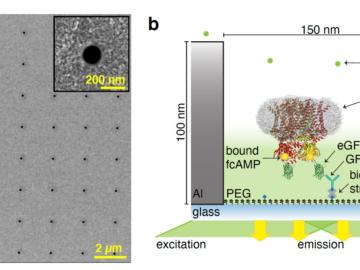
Filter News
Area of Research
- (-) Biology and Environment (14)
- (-) Materials for Computing (13)
- Advanced Manufacturing (3)
- Computational Biology (1)
- Computational Engineering (1)
- Computer Science (4)
- Energy Science (65)
- Fusion and Fission (3)
- Isotopes (3)
- Materials (55)
- National Security (11)
- Neutron Science (81)
- Nuclear Science and Technology (6)
- Quantum information Science (2)
- Supercomputing (41)
- Transportation Systems (2)
News Type
News Topics
- (-) Artificial Intelligence (6)
- (-) Microscopy (10)
- (-) Nanotechnology (8)
- (-) Neutron Science (4)
- (-) Polymers (3)
- (-) Security (1)
- (-) Transportation (4)
- 3-D Printing/Advanced Manufacturing (6)
- Big Data (9)
- Bioenergy (37)
- Biology (57)
- Biomedical (12)
- Biotechnology (9)
- Chemical Sciences (6)
- Clean Water (11)
- Composites (2)
- Computer Science (18)
- Coronavirus (9)
- Energy Storage (4)
- Environment (77)
- Exascale Computing (4)
- Frontier (3)
- Grid (2)
- High-Performance Computing (15)
- Hydropower (8)
- Machine Learning (7)
- Materials (10)
- Materials Science (12)
- Mathematics (4)
- Mercury (7)
- National Security (2)
- Partnerships (1)
- Physics (1)
- Quantum Computing (1)
- Quantum Science (2)
- Simulation (11)
- Summit (7)
Media Contacts

A study by researchers at the ORNL takes a fresh look at what could become the first step toward a new generation of solar batteries.

A team of scientists led by the Department of Energy’s Oak Ridge National Laboratory and the Georgia Institute of Technology is using supercomputing and revolutionary deep learning tools to predict the structures and roles of thousands of proteins with unknown functions.

A discovery by Oak Ridge National Laboratory researchers may aid the design of materials that better manage heat.

A team led by the U.S. Department of Energy’s Oak Ridge National Laboratory demonstrated the viability of a “quantum entanglement witness” capable of proving the presence of entanglement between magnetic particles, or spins, in a quantum material.

Oak Ridge National Laboratory researchers have developed a new catalyst for converting ethanol into C3+ olefins – the chemical

Researchers working with Oak Ridge National Laboratory developed a new method to observe how proteins, at the single-molecule level, bind with other molecules and more accurately pinpoint certain molecular behavior in complex

Through a consortium of Department of Energy national laboratories, ORNL scientists are applying their expertise to provide solutions that enable the commercialization of emission-free hydrogen fuel cell technology for heavy-duty

When COVID-19 was declared a pandemic in March 2020, Oak Ridge National Laboratory’s Parans Paranthaman suddenly found himself working from home like millions of others.

The Accelerating Therapeutics for Opportunities in Medicine , or ATOM, consortium today announced the U.S. Department of Energy’s Oak Ridge, Argonne and Brookhaven national laboratories are joining the consortium to further develop ATOM’s artificial intelligence, or AI-driven, drug discovery platform.

Researchers at the Department of Energy’s Oak Ridge National Laboratory and the University of Tennessee are automating the search for new materials to advance solar energy technologies.


